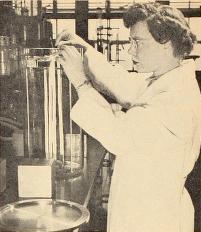Odette L. Shotwell facts for kids
Quick facts for kids
Odette L. Shotwell
|
|
|---|---|

Dr. Odette Shotwell, 1969
|
|
| Born | 4 May 1922 Colorado
|
| Died | 10 April 1998 (aged 75) |
| Nationality | American |
| Citizenship | American |
| Alma mater | |
| Scientific career | |
| Fields |
|
| Institutions | USDA Agricultural Research Service |
| Doctoral advisor | Robert Loeffler Frank |
Odette Louise Shotwell (born May 4, 1922 – died April 10, 1998) was an amazing American scientist. She was an organic chemist who studied natural products. She helped discover new antibiotics and insecticides.
Contents
About Odette Shotwell
Odette Louise Shotwell was born on May 4, 1922, in Wiley, Colorado. She grew up in Denver. When she was a child, she had polio. This illness caused her to have severe pain and made it hard for her to walk.
Her Education and Career
Odette Shotwell earned her first college degree from Montana State College. She then went to the University of Illinois. There, she earned both her Master of Science degree and her Ph.D. in organic chemistry. She finished her Ph.D. in 1948.
After finishing her studies, Dr. Shotwell started working. She joined the USDA/Agricultural Research Service in Peoria, Illinois. The USDA is a part of the United States government that helps farmers and keeps our food safe. She worked there for 25 years as a research chemist. She retired from her important work in 1990.
Helping Her Community
Dr. Shotwell cared deeply about helping others. She worked to make things better for people with disabilities. She also fought for equal opportunities for women and people of color in science.
She was a leader in her local NAACP group. The NAACP works for civil rights and equality. She led a team of 40 volunteers to help tutor children who needed extra support. She also helped schools in Peoria become integrated in the 1960s. This meant schools welcomed students of all races.
Odette Shotwell was also the president of the Peoria Chapter of the League of Women Voters. This group helps people understand how to vote and get involved in their community. She also helped with other local projects, like advising on education for a city program and serving on the board of an arts and sciences center.
Her Important Research
As a research chemist, Dr. Shotwell made many important discoveries. She found two new antibiotics called duramycin and azacolutin. Antibiotics are medicines that fight infections caused by bacteria. She also helped find two other antibiotics. She even found new ways to separate these medicines from the tiny living things that make them.
By 1974, she became a leader in her field. She led a team that studied Mycotoxins. Mycotoxins are harmful substances made by certain molds. Her team also worked on finding new insecticides. Insecticides are chemicals used to kill insects. They focused on studying Japanese beetles.
Dr. Shotwell is best known for her work on mycotoxins. She especially studied aflatoxin. Aflatoxin is a substance made by mold that grows on foods like rice and corn. This substance can be very dangerous. It can cause cancer and other health problems in animals and even humans.
In the late 1980s, she became the leader of the Mycotoxin Research Unit. She taught the Federal Drug Administration (FDA) how to find contaminated grain. She showed them how to use ultraviolet light to spot the mold. She also helped set safety rules for storing grain.
In 1980, she received a special award from the USDA. It was for "contributing to the protection of human health." Her work helped keep mold toxins out of our food, milk, and animal feed.
Later, Dr. Shotwell led a group studying Fusarium fungi. These fungi also produce harmful toxins. Her team worked to design ways to stop these fungi from growing.
Throughout her career, she was a member of many important groups. She was even the president of the Association of Official Analytical Chemists (AOAC). She helped make sure that scientific tests were done correctly and safely.
Her Patents
Dr. Shotwell also held several patents for her discoveries:
- 1957 – A way to make an antibiotic mixture that fights both bacteria and fungi.
- 1959 – A method to get azacolutin from a type of bacteria called S. cinnamomeus var. azacoluta.
- 1964 – The discovery of almarcetin and how to make it using Streptomyces albus.
Awards and Recognition
Dr. Shotwell received many awards for her amazing work:
- Outstanding Woman Alumna of the Year (Montana State College, 1961)
- USDA Nomination for Outstanding Handicapped Federal Employee of the Year (1969) – She was one of the first 10 finalists for this award.
- Distinguished Service Award (USDA, 1980) – This was for her work protecting human health.
- The Harvey W. Wiley Award (Association of Official Agricultural Chemists (AOAC), 1982) – This is a very important award in analytical chemistry.

